Magicboard movies
| François | IIHM | CLIPS | IMAG |
Magicboard movies |
|
| Finger Tracking 2004 | Finger Tracking sequel | Finger Tracking | Magic Table | Magic Board | Finger Paint |
Finger tracking 2004 |
(Oct. 2003-Apr. 2004) | |||||
|
This work was realized by Julien T. Letessier while preparing his Master's thesis and PhD. This system is described in the paper |
||||||
Finger trackingft2004-movie-mpeg4.avi 88.2 MB ft2004-movie-mpeg4-small.avi 12.2 MB |
 |
This video demonstrates the finger tracking system, its evaluation, and a sample application. The system processes quarter-NTSC (320x240 pixel) frames at 25 Hz on a low-end machine, with 80 ms latency and requires no initial software setup or maintenance.
The system tracks an aritrary number of fingers, in various lighting conditions, and is not perturbated by shadows. |
||||
Finger tracking 2003 |
(Sep. 2002-Jul. 2003) | |||||
|
||||||
Finger detectionft-movie-1-divx5.avi 6.5 MB ft-movie-2-divx5.avi 5.7 MB ft-movie-3-divx5.avi 8.8 MB |
 |
Demonstration of the finger detection system. The system processes 320x240 frames at 20 Hz on low-end machines, and requires no initial software setup.
The system tracks an aritrary number of fingers, in various lighting conditions, and is not perturbated by shadows. |
||||
|
Common movie caption:
Movie captions:
|
||||||
Finger tracking 2001 |
(Feb.-Jun. 2001) | |||||
|
||||||
Finger detectionfingerdetect.mpg 2.1 Mb |
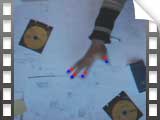 |
Demonstration of the finger detection system. The system is able to search for fingers in the entire 384x288 (quarter PAL) image at 25 frames per second.
The system can actually track fingers on many hands and identify which finger belongs to which hand. |
||||
Brainstormbrainstorm.mpg 3.9 Mb |
This video shows that more than one user can interact with the system (multiple-user two-handed interaction is actually possible). The system tolerates unconstrained movements (i.e. high acceleration) from the users. |
 |
||||
Presentationpresentation.mpg 6.9 Mb |
 |
The user controls a powerpoint presentation with gesture. Showing 2 fingers is "next slide", 3 is "previous slide". Showing all the fingers calls the "slide sorter" where the user designates with one finger the slide number he wants to access directly. | ||||
Web surfingwebsurf.mpg 2.7 Mb |
Control of a web browser with one finger. Mouseclicks are generated if the finger rests at the same position for half a second. | 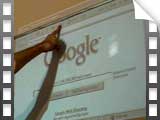 |
||||
Magic Table |
(year 2000) | |||||
| This system was realized at the MIT Media Laboratory in the Vision and Modeling group as part of the Facilitator Room project. Executes on a PC (Pentium III @ 833 Mhz) |
||||||
MagicTablemagictable.mpg 23.9 Mb |
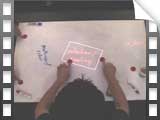 |
This is an horizontal implementation of the board (i.e. the board is a table). Red tokens (small disks made of plastic) are used instead of fingers. The choice was made initially because finger tracking was not stable enough, then we realized that graspable object may be better for some tasks (because of the physical embodiement they provide). |
||||
Magic Board |
(year 1999) | |||||
| ENSIMAG end of studies project from Sébastien Annedouche, Benoît Loup and Michel Prodhomme. Executes on a PowerMacintosh 8600 (PPC 604 @ 350 Mhz) or an SGI O2 (R10000 @ 150 Mhz) A web page describe this project in more details. |
||||||
Magic Boardmagicboard.mov 19.6 Mb (quicktime, sorenson) |
First fully functionnal implementation. Clicks are simulated by pauses (static finger) of 0.5 second. | 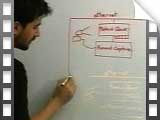 |
||||
Finger Paint |
(June 1994) | |||||
| First prototype on the project. Executes on a Macintosh Quadra 840av (68040 @ 40 Mhz) A web page describe this project in more details. |
||||||
Finger Paintfingerpaint.mov 8.3 Mb (quicktime, cinepak) |
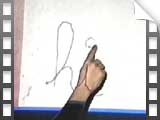 |
Drawing virtual ink on the board with a finger / a pen. The tracking (by correlation) requires manual initialization. Clicks are "simulated" by someone pressing a key on a keyboard. |
||||
| François | IIHM | CLIPS | IMAG |